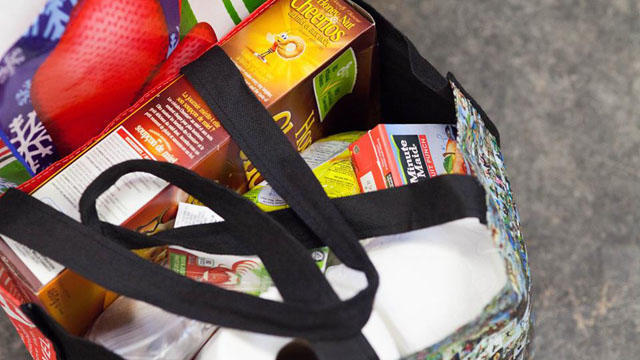How some companies are working to reduce food waste in Ontario
Published February 12, 2021 at 1:00 pm

Preventing food waste is incredibly important to Fraser Fitzgerald, owner of That Planted Fork – a company that provides dinners, cooking classes, and menu development to people across the GTA.
“Food waste is something, like many things in our society that goes on unknowingly to the public,” Fitzgerald said in an email. “People take their trash to the curb every week and once it’s there, the trash magically disappears, and we never think about it again.”
It may be easy to forget for some – out of sight, out of mind. However, food waste is not going completely unnoticed. According to the Recycling Council of Ontario, in 2015 alone Ontarians produced roughly 3.7-million tonnes of food and organic waste.
“Which includes food that could have been eaten or repurposed, as well as unavoidable waste, such as food scraps and vegetable peelings,” reads the website, noting that around 60 per cent of this was sent to landfills.
The Ontario Food and Organic Waste Framework, released in 2018, noted that keeping food and organic waste out of landfills can help the province tackle climate change by diminishing greenhouse gas emissions.
How can the province keep food waste out of landfills? According to Fitzgerald, education is crucial.
“It’s important to educate consumers on waste because there is nowhere for it to go, so minimizing your waste can go a long way in saving our planet,” Fitzgerald said. “Composting is also important and supporting organizations that are creative with food waste and extra product.”
When it comes to That Planted Fork, Fitzgerald said he tries to reduce food waste by focusing on using the same ingredients in meal kits, reinventing products, and just buying exactly what he needs.
FoodFund Canada is another organization working to minimize food waste in Ontario. FoodFund delivers ‘recovered’ fruits and vegetables to doorsteps across the GTHA (including Hamilton, London, Waterloo, and surrounding areas).
https://www.instagram.com/p/CKXVJrJnDaq/
But what does ‘recovered’ mean?
According to the company’s website recovered foods are just as nutritious and appetizing as the produce you may buy in a store; they just might have bumps or marks.
“Just like people, produce comes in a wide variety of shapes, sizes, and colours and we think such diversity should be accepted,” reads the company’s website.
Divyansh Ojha, the founder of FoodFund said he has always been a bit conscious and aware of the food industry.
“Just reading up on it, it kind of occurred to me that, as a country, we are quite blessed to have a really strong infrastructure around agriculture, but there’s still a lot of waste,” Ojha said.
“Why that is and how we can curb it? [Those] were kind of the next two questions, logical, questions that came up. I realized a lot of it has got to do with cosmetic imperfections, strict retail standards, inefficiencies around how we can deal with surplus.”
Ojha further explained how the concept of FoodFund came about: “A simple model of just working directly with the growers and stores, that holds the kind of the most power in this industry right now. That was the idea, if we can just cut them out, and go directly from grower to household.”
Not only does FoodFund work toward reducing food waste, but the company also prioritizes reducing hunger, supporting growers, and empowerment. But when it comes to food waste, Ojha noted that Ontarians should be concerned.
“An alarming percentage of Ontarians that are affected by this [food waste],” Ojha said.
“Not only do we need policy reforms around how businesses and larger companies deal with surplus food, and what are the laws regarding donation and things. But as a consumer, your lack of consciousness eventually costs everyone more.”
Ojha further expanded: “If we continue to be picky and pick an apple up in the store and inspect it, as we’re inspecting our next big purchase, eventually, it’s going to take 100 apples to get one [you’d] buy. Is it that important for us to make sure it’s completely freckle free, even coloured, perfectly shiny, etc.? The more we waste, the more we reject, [and] farmers and growers cover up for those costs with the produce that is actually able to sell. If you’re not paying attention, if you’re not concerned, then you’re going to be stuck in this vicious cycle of rising food prices and increasing food insecurity as prices keep going up. You’re kind of stuck in this loop.”
The Ontario Food and Organic Waste Framework revealed that around 50 per cent of food waste is avoidable and that, ‘The average household throws out 125 kg of food waste per year.’ This is the equivalent of nearly 275 lbs., and more than 300 meals.
So, how can Ontarians limit their food waste? According to Ojha, the basics can go a long way.
This means going to the grocery store with a plan, setting a budget, and limiting impulse purchases. Having a plan is key. While Ojha noted there are ways to limit food waste, he also noted that there’s no silver bullet solution. He also revealed that he doesn’t see the issue of food waste completely going away.
“I think even having the notion that there can be a solution already is a deterrent for people to start to try and maintain because they’re not going to see much progress,” Ojha said.
“By saying there’s a solution almost implies that it can be fixed, or the problem can go away once and for all. I think that is flawed, in a sense. Personally, I don’t ever see this problem going away, I see it being contained.”
insauga's Editorial Standards and Policies advertising





